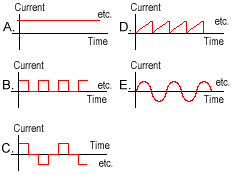Which of the following must be known or measured for calculating apparent resistivity from DC measurements. Choose ONLY those that are required.
- Porosity
- Source current in amps injected at one pair of electrodes
- Voltage at a second pair of electrodes
- Temperature of ground at these electrodes
- Geometry of the four electrodes
- Water saturation
- Grain size distribution
- Current density due to spontaneous potentials
- Porosity
As a consequence of boundary conditions, which of the following is true about simple profiles of apparent resistivity (DC resistivity measured with a single electrode spacing at stations along a line)?
- Profiles will always appear smooth.
- They can appear discontinuous across vertical contacts between different geologic units.
- Profiles can occasionally have negative values near boundaries.
- They never have values equal to true (or intrinsic) resistivities.
- Profiles must be inverted before useful results can be obtained.
 Which of these figures most closely resembles the transmitter waveform that is usually used for DC resistivity work?
Which of these figures most closely resembles the transmitter waveform that is usually used for DC resistivity work?- A.
- B.
- C.
- D.
- E.
Approximately how many orders of magnitude does the resistivity of all earth materials span (enter an integer)? (After two wrong attempts, this changes to a multiple choice question.)
- 1
- 3
- 6
- 9
- 12
Which ONE of the following does NOT affect the resistivity of a geologic unit?
- Porosity
- Fluid type
- Fluid salinity
- Presence or absence of metallic minerals
- The proportion of clay minerals in the sample
- The type of rock making up the sample’s solid portion
Resistivity is basically _________ per unit volume. The word that fills the blank is not a physical property, whereas resistivity is.
In a DC resistivity survey, the measurements are usually plotted for inspection or for direct interpretation after being transformed into what form? (After two wrong attempts, this changes to a multiple choice question.)
- potential
- current
- resistance
- true resistivity
- apparent resistivity
When current is injected into the ground using two electrodes, there is one plane within the earth where all the current vectors are oriented in exactly the same direction. Where is that plane? Use the interactive figure showing current flow within the ground.
- A vertical plane that is perpendicular to a line connecting the electrodes, and is positioned under the centre point between the two electrodes.
- A vertical plane that is perpendicular to a line connecting the electrodes, and is positioned under the positive electrode.
- A vertical plane that is perpendicular to a line connecting the electrodes, and is positioned under the negative electrode.
- A horizontal plane cutting through both electrodes.
- A vertical plane cutting through the two electrodes.
From the figure of the Elura ore body, through which material are DC currents expected to diverge (rather than converge)?
- Overburden
- Gossan
- Pyritic mineralization
- Pyrrhotite mineralization
From the figure of the Elura ore body, where are positive charges expected to accumulate?
- Where current crosses into a more resistive material?
- Where current crosses into a more conductive material?
Why are transmitter currents injected with a particular current pattern or waveform?
- Because transmitters are less expensive when the waveform is used.
- Because it saves power.
- The receiver can read this type of waveform more easily.
- The waveform helps remove spurious turbulent currents in the ground that can cause data to appear noisy.
- There are spontaneous potentials in the ground that must be removed from measurements.
Of the following five options, which is the best definition of "apparent resistivity"?
- Measured voltage divided by known input current.
- The resistivity of the ground surrounding the transmitter electrodes.
- The resistivity of a halfspace under the receiver electrodes.
- A value in units of resistivity obtained using measured voltage, known input current, and electrode geometry.
- The same as true resistivity, unless the spontaneous potential effect has not been removed.
There are many named survey configurations that can be made using four or fewer electrodes. Which two rather different configurations have the same geometric factor?
- Wenner and Schlumberger
- Schlumberger and dipole dipole
- Dipole dipole and dipole pole
- Dipole dipole and pole pole
- Pole pole and Wenner
Which type of DC resistivity survey is most appropriate for finding the thickness of an aquifer at one location?
- Soundings
- Profiling
- Three dimensional configurations
- Azimuthal arrays
- Borehole
Which type of DC resistivity survey is most appropriate for finding out how the thickness of overburden varies under a stretch of roadway?
- Soundings
- Profiling
- Three dimensional configurations
- Azimuthal arrays
- Borehole
Which type of DC resistivity survey is most appropriate for identifying the trend of subsurface fractures under thin overburden?
- Soundings
- Profiling
- Three dimensional configurations
- Azimuthal arrays
- Borehole
Which type of DC resistivity survey is most appropriate for estimating thrue resistivity in a geologic unit that is only a metre thick but lies at 80m depth?
- Soundings
- Profiling
- Three dimensional configurations
- Azimuthal arrays
- Borehole
Which type of DC resistivity survey is the most difficult to interpret?
- Soundings
- Profiling
- Three dimensional configurations
- Azimuthal arrays
- Borehole